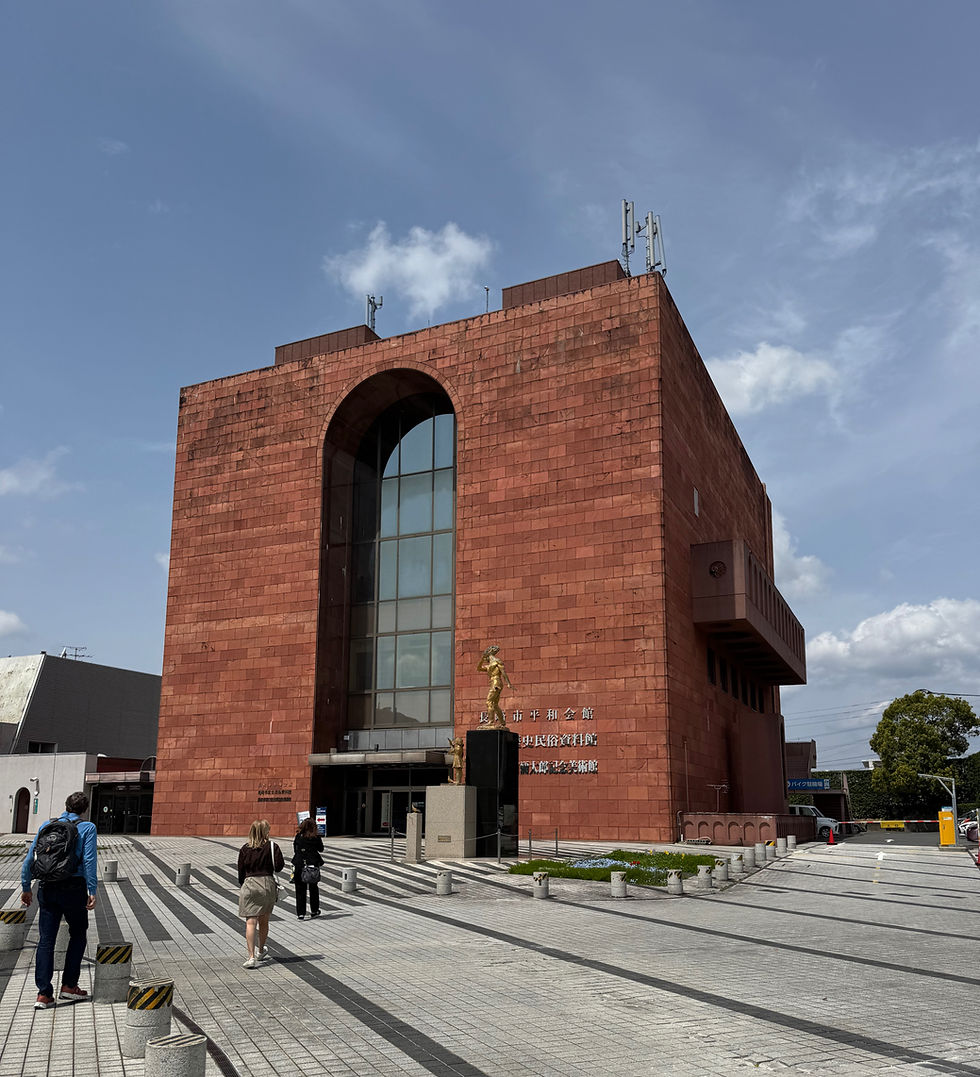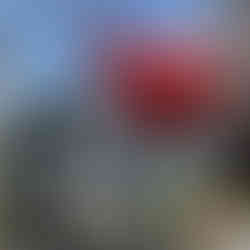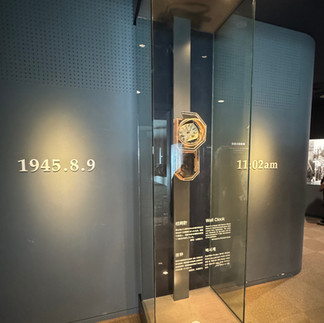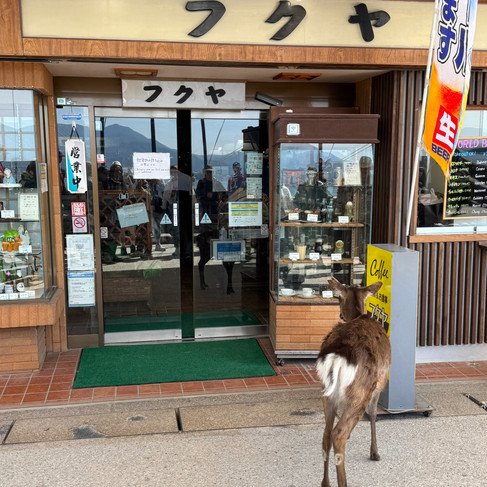Japan - Kagoshima, Nagasaki and Hiroshima
- Fernanda Fisher
- Jul 21
- 7 min read

Kagoshima: Volcanoeds and Samurais
Beautiful Kagoshima was one of my favorite places to visit, in part because we witnessed the volcano, “burping" several times. According to our guide the Japanese only count eruptions that reach over a certain height. Sadly, or luckily perhaps, we didn’t see an actual eruption on our day here.
With a large boat and many bus loads of visitors, Oceania did a great job of spreading us all out. Today, our bus stopped at Caron to have lunch before starting our sight-seeing. We were introduced to a Japanese style of cooking called shabu shabu.

Shabu shabu consists of thinly sliced raw meat and vegetables brought to the table along with a small pot of broth. A sterno candle heats the broth from below.
After the broth began to boil, we placed the vegetables in to cook for a few minutes. Using our chopsticks, we took a piece of meat and moved it through the bubbling broth until it was no longer pink. This process is called shabu shabu. They had so many items to choose from at lunch but all in small portions. Japanese meals leave you satisfied not stuffed.
After lunch we had a chance to walk around the little area near the restaurant.
Samurai Lane in Chiran
Built in the 1700s Chiran was a castle town created to protect the feudal lords of Satsuma.
Houses are hidden behind imposing hedges and walls.
The houses on Samurai Lane are considered national landmarks of a time past and have not changed since their creation. Many homes are still owned by the descendants of the samurai. While there, we saw several gardens and the exteriors of the homes. I could have spent far more time at each house but we were on a schedule.
Though functionally alike in many ways, each was unique. Traditional Japanese gardens all contain the same basic themes. They have rocks and plants and many also have a water feature. Rocks symbolize stability and mountains, water represents life and reflection. There are other elements that may be added but rocks, plants and water are mainstays.

Samurai Lane contains only one water garden. Only the highest ranking Samurai had a water garden because this is where the feudal lord would stay when he visited. Therefore it marked the house as having a higher status.
While some in our group said the gardens “all looked alike,” I enjoyed paying attention to how each garden harmoniously tried to capture the natural beauty within the walls of the garden as well as the external surroundings. Strolling down the quiet lane with no one else around, I expected a Samurai to come walking towards me.
Black sand beach visit
Kagoshima is located not far from Mt. Sakurajima, one of 111 active volcanoes in Japan. We visited a beach made entirely of black sand. As the sand sifted through my fingers, I was amazed at just how soft and smooth the grains were.

You can take a sand bath at Ibusuki but we did not have an opportunity to try one. Supposedly, you are buried to your neck in the sand and then you go wash off in the hot springs. Certainly not an option for someone who is claustrophobic!

The volcano burped gas, while we stood on the beach! It is the most thrilling sight to witness an active volcano when it is not harming anyone. Our guide smiled and explained patiently to us that this happens all the time with Sakurajima. Most of us had never seen a volcano emit gas so we anxiously hoped the gas would rise high enough into the clouds to formally count as an eruption.
Green Tea vs. Matcha Tea
Kagoshima is known as a leader in green tea production. If you read my blog on Tokyo, you already know that I am now mildly obsessed with Matcha. Matcha is a form of green tea that is ground into a powder. The powder is whisked into hot water by hand with a special wood whisk.
I was able to attend a traditional tea ceremony, though we did not sit on the mats like the woman performing the ceremony did. People in our group were bashful to be the first to try the tea so I volunteered and learned that you hold the bowl with two hands.


Milk and a sort of simple syrup may be added as well for sweetness. Matcha has more caffeine than regular tea and slightly less than coffee. It has a pleasant flavor that is very different from other hot beverages I have tried.

I learned that green tea is made from young tea leaves. Green tea tends to have a more pronounced flavor than black tea does. As we drove in the bus today, we saw fields of green tea on both sides.
Worth noting is that the fields in Japan are mere blips compared to the types of fields found in the U.S. If I were to guess, they all look like private family farms. In fact, there was never a discussion during our travels of commercial Japanese farming.
Nagasaki: A Somber Reflecion

Our visit to Nagasaki was a somber one. Of the two sites where the atomic bomb dropped, I chose to focus on Nagasaki. I learned that Nagasaki was not the original American choice as a target. The U.S. originally chose a military installation outside of town, but on the night of the bombing, it was too cloudy to drop the bomb. Instead of waiting until the skies cleared they chose to drop the bomb on Nagasaki.
Remains of a bombed church, a clock stopped at the time the bomb hit, and the spot where bomb landed.
I can only compare the Nagasaki Peace Park and museum to my visit of the U.S. Holocaust Museum in D.C. The museum describes what happened before, during, and after the bombing.
It was gut wrenching to see black and white photos of charred human remains. The color photos of the burn victims were challenging to see as well. I left the museum afterwards and thought how terrible it would be for something like this to ever happen anywhere again.
Our guides in both Nagasaki and Hiroshima directly addressed their country’s role in the war. Each of them said that their government was to blame and that even more people would have been killed had it not ended as it did.
I don’t know if this was a prepared speech they were asked to give. There was never an apology for the bombing of Pearl harbor, or any of the other atrocities that the Japanese committed. However, they lost 73,884 people in one city and another 74,000 that were injured and left with diseases from the attack. Perhaps the Japanese felt that each side suffered an equal amount.

The Peace Park is located outside the museum. The focus point here is a huge blue man. One arm points to the sky - symbolizing where the bomb came from. His other hand stretches out looking for peace. One leg is folded in a meditation pose while the other is bent and ready to spring in to action.
Sculptures donated by foreign cities and countries to the Peace Park.
The Japanese consider all aspects in both art and gardens. This juxtaposition of recognition, thought, hope and action truly symbolizes what they hope will result from the bombing - an end to war.
Make sure to take time to stroll through the park and look at the sculptures. Each piece was donated by a different country and each donated piece is meant to affirm a need for peace and a determination that this type of war should never happen again.
Hiroshima: A Blend of History and Culture
This port stop was the only chance I could visit the famous floating Torri gate. There was no way I would miss seeing this on what may be my only trip to Japan. When I signed up for the cruise and picked our tours, Miyajima was already full. But I was determined to see it.
It pays to ask more than once when you care about seeing or doing something. The first day on the ship I asked if there was a waitlist for Miyajima. Luckily several spaces became open so I said yes to the tour.
Miyajima Island is a UNESCO World Heritage site. The official name of the shrine is Itsukushima, but most people refer to it as Miyajima instead. The shrine is red lacquer throughout, which contrasts beautifully to the surrounding water colors.

We were partly lucky on our visit to the island because the tide was at least covering the base of the gate. The water was low enough that people could walk out to it, but it did not distract from the breathtaking view of the giant gates set in the water.




Be prepared for loads of people here, since this is a heavily touristed spot by both Japanese and foreign visitors. It was nearly impossible to take photos or just stop to appreciate the beauty without people moving around us.
Miyajima was a highlight of the trip. If you are able to visit, make sure to check on the pagoda's restoration. It was shrouded in tarps and closed when we were there.

Having not had lunch and being hungry, I summoned the courage to try and order several kinds of street food from the mostly Japanese-speaking vendors. Pointing at items and using just a little English I secured several items.
Deer on the island are very tame and come right up to the shops. Visitors are warned not to pet them.
My first taste was beef curry in a pillow of fried dough. I can’t describe it any other way. The filling was flavorful with tender chunks of beef and curry flavored sauce. The second thing I tried was a specialty on the Island.

Shaped like a maple leaf, with the consistency of a pancake, you can chose from different kinds of fillings (bean paste, fruit, etc).
I opted for apricot, and it was delicious. My final discovery was Matcha ice cream - yummy! In fact, while writing this review, my mouth is watering at the memory of all those tasty morsels.

I’d like to acknowledge here that Hiroshima is a beautiful city. It is the city more widely known than Nagasaki for its peace initiatives. In 1949 the Japanese parliament proclaimed Hiroshima a City of Peace at the suggestion of the city’s mayor. The Hiroshima Peace Institute was established in 1998 within Hiroshima University.
If you cannot see the Nagasaki Peace Memorial, then I would strongly encourage you to visit the one in Hiroshima. Plan two days here if you need to see both Miyajima and the Peace Institute.




































Comments